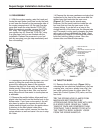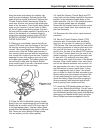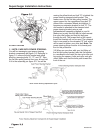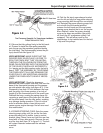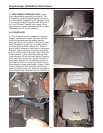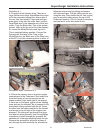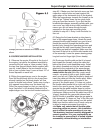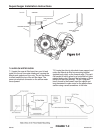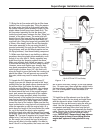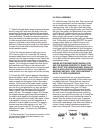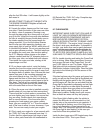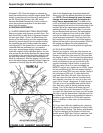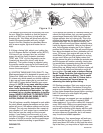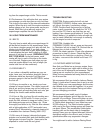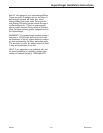
The dashpot tip should just be touching the throt-
tle arm. Adjust the dashpot so that this contact
point is at 3000 rpm or more to help with the
drooping idle. Your Miata will drive best with the
lowest idle speed possible with only a slight
droop in the idle (checked as described above
with a warm engine, lights and heater fan on
high).
9.4 Using a timing light, adjust your ignition tim-
ing to 6 degrees before top dead center (BTDC).
You have to run a jumper wire (an unfolded
paper clip will do nicely) between terminals
“GND” and “TEN” of your diagnostics center
(located just above the driver’s side shock
absorber). The ignition timing is adjusted using
the position sensor mounted at the firewall end
of the intake camshaft. A 12mm box wrench will
loosen the securing bolt.
9.5 IGNITION TIMING AND FUEL QUALITY: Your
Miata supercharger kit is designed to operate on 91
Octane fuel. Make sure that you run your engine on
91 octane only, which means you should complete-
ly burn up any lower octane gas in your tank and
refill it with 91 octane before installing your super-
charger kit. NOTE: In any case, should you ever
hear “pinging” or knocking from your engine
when under acceleration, you should take
measures to eliminate this detonation, i.e. high-
er-octane fuel or a further retardation in ignition
timing. NEVER CONTINUE TO OPERATE YOUR
ENGINE IF YOU HEAR ANY SIGNS OF DETO-
NATION (PINGING OR KNOCKING).
This kit has been carefully designed to work within
the stock Mazda engine parameters and no deto-
nation will occur if the above settings and fuel are
followed. The only way detonation can creep into
your situation is if your engine has a mechanical
fault, the fuel you are using is of the incorrect
octane, if your timing is set incorrectly or if your
fuel filter is clogged. It is your responsibility as the
installer of this kit to ensure that the supercharger
has been installed according to specification.
DRIVING TIP:
If you should find yourself in a situation where you
cannot find high-octane fuel, you can bypass the
supercharger temporarily. Note the position the
bypass actuator arm is in during idle. This is the
position that bypasses the boost air back into the
supercharger inlet. As you blip the throttle, the
actuator arm will move and close a butterfly valve
inside the bypass manifold. Using a short piece of
wire, fix the bypass actuator arm in the “bypass”
position that it holds at idle. This will prevent boost
from being developed and thus, detonation will not
occur. Of course, your engine will now run like a
stock Miata, but will be quite operable for as long
as you need. When you find higher-octane fuel,
simply remove the wire to release the actuator arm
and the bypass will function normally, closing dur-
ing acceleration, bypassing during idle and cruise.
Try to run the low octane fuel out of your tank
before filling up. Mixing fuels of different octane will
lower the overall rating and detonation could still
be a problem. You can order a Jackson Racing
Boost Timing Controller that retards your tim-
ing during boosted conditions. This is useful
for those who can only find 91 Octane fuel or
wish to increase their low-end power by
advancing the static ignition timing.
9.6 Starting procedure: Start your engine as you
would a standard Miata. Remember to bring the
engine up to operating temperature (as indicated
by your water temperature gauge) before running it
hard. Full boost on a cold engine will greatly
increase your engine wear.
9.7 Oil changes: we suggest you use synthetic oil
such as Mobil 1 and change it regularly (5000
miles maximum). If you use a mineral oil, change it
every 2500 miles. While your supercharger does
not use any engine oil for its lubrication, your
engine will be working a little harder with the addi-
tion of a supercharger. The synthetic oil provides
an extra measure of protection, but is not neces-
sary for safe and reliable operation.
9.8 Breaking-in: Your supercharger will work per-
fectly from the first time you fire it up. However, it
does need about 500 miles to fully seat the rotors.
Up to that time, you may notice a slight noise com-
Supercharger Installation Instructions
999-156 -15- Revised 1/07
Figure 9.4



